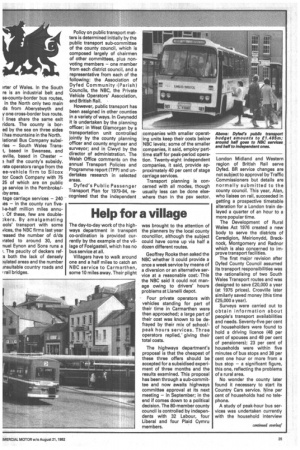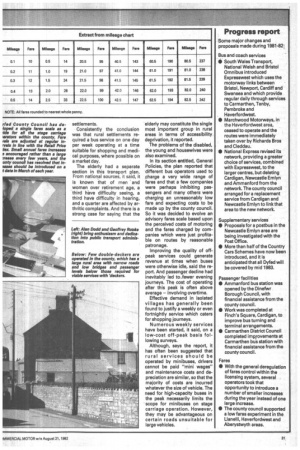Dilemmas in Dyfeci land of contrasts
Page 22

Page 23

Page 24

Page 25

If you've noticed an error in this article please click here to report it so we can fix it.
Transport planners in Dyfed grapple daily with intractable problems posed by geography. The population is distributed unevenly over a quarter of Wales and nearl 40 per cent are an hour from the nearest bu stop. John Durant talks to two of the county's planning officers
MAE Deddf Trafnidiaeth 1978 ynI ei gwneud yn ofynnol ar gynghorau sir baratoi a chyhoeddi cynlluniau trafnidiaeth gyhoeddus yn flynyddol, bob un yn son am y bum mlynedd ddilynol.* While the Transport Act requires county councils to prepare and publish annual public transport plans, each relating to the following five years, the policy of Dyfed County Council is to publish them in both English and Welsh.
However, when I visited thej Carmarthen offices of the council's highways department, whom should I meet but two Englishmen: Geoffrey Rooke, public transport administrator, and Alan Dodd, senior transportation assistant.
This year Dyfed's public transport budget amounts to £1.405 million (excluding for schools, an additional and approximate £3m), they explained.
The major change from previous years' budgets is that Transport Supplementary Grant (TSG) is no longer available for the revenue expenditure of the highways and transportation committee, expenditure on revenue support now being absorbed into the -Rate Support Grant (RSG) settlement.
Each Welsh local authority is allocated RSG on the basis of "assessed need" as determined by standard formulae applied to each authority. The factor used for the grantrelated expenditure assessment of revenue support for each county council is based solely on resident population, which the county council considers to be an unsatisfactory measure of the need for public support for passenger transport services.
The county council is trying to amend the basis of distribution for future years as it feels that the current method discriminates against the rural counties such as Dyfed; no account is taken of more relevant factors affecting support for public transport such as the lower density of population or the age structure of rural communities.
"This change," said Geoffrey, "came as a bolt out of the blue. Many English colleagues are unaware that this has happened. But the Government may have it in store for England at a later date."
Geoffrey came into local government in 1975 from Midland Red. Alan came a year later from Aberystwyth University. TI new counties had been esta lished only in 1974 as a result the Local Government Act 197 and a new discipline had to I established; this is where ti two Englishmen came in, al they have never regretted they are enthusiastic about t quality of life in Dyfed, but fu expect that when the day corn to leave, they will be succeed by Welshmen.
Dyfed (formerly Ca marthenshire, Cardiganshi and Pembrokeshire) has population of 325,000 and acreage consists of just over irter of Wales. In the South re is an industrial belt and ss-county-border bus routes, in the North only two main ds from Aberystwyth and y one cross-border bus route. I lines share the same exit ridors. The county is bored by the sea on three sides I has mountains in the North. lational Bus Company subsiries — South Wales Transt, based in Swansea, and sville, based in Chester — 1 half the county's subsidy. rate operators range from the ee-vehicle firm to Silcox tor Coach Company with 75 25 of which are on public je service in the Pembroke/by area.
tage carriage services — 240 es — in the county run five-a-half million million miles annu. Of these, few are double;kers. By amalgamating ools' transport with some vices, the NBC firms last year -eased the number of d/ds mated to around 30, and nuel Eynon and Sons runs a r. The paucity of deckers refs both the lack of densely )ulated areas and the number insuitable country roads and r rail bridges.
Policy on public transport matters is determined initially by the public transport sub-committee of the county council, which is composed largely of chairmen of other committees, plus nonvoting members — one member from each district council, and a representative from each of the following: the Association of Dyfed Community (Parish) Councils, the NBC, the Private Vehicle Operators' Association, and British Rail.
However, public transport has been assigned in other counties in a variety of ways. In Gwynedd it is undertaken by the planning officer; in West Glamorgan by a transportation unit controlled jointly by the county planning officer and county engineer and surveyor; and in Clwyd by the director of administration. The Welsh Office comments on the annual Transport Policies and Programme report (TPP) and undertakes research in selected areas.
Dyfed's Public Passenger Transport Plan for 1979-84, recognised that the independent companies with smaller operating units keep their costs below :NBC levels; some of the smaller ;companies, it said, employ'part'time staff for peak-period operation. Twenty-eight independent companies, it said, provide approximately 40 per cent of stage carriage services.
Transport planning is concerned with all modes, though usually less can be done elsewhere than in the psv sector. London Midland and Western region of British Rail serve Dyfed. BR service changes are not subject to approval by Traffic Commissioners but details are normally submitted to the county council. This year, Alan, who liaises on rail, succeeded in getting a prospective timetable alteration for a London train delayed a quarter of an hour to a more popular time.
The Development of Rural Wales Act 1976 created a new body to serve the districts of Ceredigion, Meirionydd, Brecknock, Montgomery and Radnor which is also concerned to improve transport facilities.
The first major revision after Dyfed County Council assumed its transport responsibilities was the rationalising of two South Wales Transport routes and was designed to save £20,000 a year (at 1975 prices). Crosville later similarly saved money (this time £25,000 a year).
Surveys were carried out to obtain information about people's transport availabilities and needs. Seventy-five per cent of householders were found to hold a driving licence (48 per cent of spouses and 49 per cent of pensioners); 23 per cent of households were within five minutes of bus stops and 38 per cent one hour or more from a bus stop — a significant figure, this one, reflecting the problems of a rural area.
No wonder the county later found it necessary to start its Country Cars service. Nine per cent of households had no telephone.
A study of peak-hour bus services was undertaken currently with the household interview survey to identify a base network of daily peak services. Most buses were shown to be underutilised, said the report, but withdrawal would severely deprive many areas of access to and from work centres and schools and put extra burdens on the education department to transport school children under their statutory duties.
The rural part of Dinefwr district was designated by the Government as one of the four areas of Great Britain to benefit from a series of rural transport experiments, RUTEX, with the purpose of helping rural communities with inadequate or threatened public transport services.
Transport needs are fulfilled by unconventional modes such as postbus, schoolbus and social car services. Surveys were undertaken by the county council shortly after the introduction of the postbus services and again five months and nine months later to assess the effect of seasonal factors and travel patterns.
The financial and technical responsibilities of the RUTEX services were transferred from the Welsh Office to the county council in December, 1978: However, a local Committee, known as the North Dinefwr Supplementary Transport Cornmittee, was formed to organise and supervise the management of supplementary transport ser vices in the area, and to advise the county council.
The staggering of school hours it was thought, could assist in creating a more efficient transport system by enabling one vehicle to make more than• one journey in conveying pupils to different schools, particularly to secondary and junior/infant schools, and this flexibility in hours should be encouraged. However, a proposal to advance
the finishing times at one school was found to necessitate additional peak-hour buses to serve the primary schools in the area at a considerable cost to the bus company concerned and thus to the county council.
In the more densely populated areas, Dyfed assumed that need can be interpreted from transport demand and service revisions have been based upon passenger surveys. Generally, an hourly service has been adopted where more than 600 passenger journeys have been identified during the period between 0800 and 1800, and a twohourly service has been adopted where more than 300 passenger; journeys have been identified.
In the very rural areas, however, there is insufficient public transport for people to have a reasonably free choice and household interviews were undertaken in selected typical settlements.
Consistently the conclusion was that rural settlements required a bus service on one day per week operating at a time suitable for shopping and medical purposes, where possible on a market day.
The elderly had a separate section in this transport plan. From national sources, it said, it is known that of men and women over retirement age, a third have difficulty seeing, a third have difficulty in hearing, and a quarter are affected by arthritic complaints. And there is a strong case for saying that the elderly may constitute the single most important group in rural areas in terms of accessibility, deprivation, it reported.
The problems of the disabled, the young and housewives were also examined.
In its section entitled, General Policies, the plan reported that different bus operators used to charge a very wide range of fares and that a few companies were perhaps inhibiting passengers and many others were charging an unreasonably low fare and expecting costs to be made up by the county council. So it was decided to evolve an advisory fares scale based upon the perceived costs of motoring and the fares charged by companies which were just profitable on routes by reasonable patronage.
Improving the quality of offpeak services could generate revenue at times when buses were otherwise idle, said the report. And passenger decline had inevitably led toJewer evening journeys. The cost of operating after this peak is often above average — involving overtime.
Effective demand in isolated villages has generally been found to justify a weekly or even fortnightly service which caters for shopping journeys.
Numerous weekly services have been started, it said, on a low-cost off-peak basis following surveys.
Although, says the report, it has often been suggested that rural services should be operated by minibuses, drivers cannot be paid "mini wages" and maintenance costs and depreciation are similar, so that the majority of costs are incurred whatever the size of vehicle. The need for high-capacity buses in the peak necessarily limits the scope for minibuses on stage carriage operation. However, they may be advantageous on certain roads unsuitable for large vehicles.










































